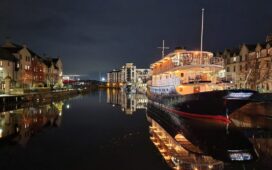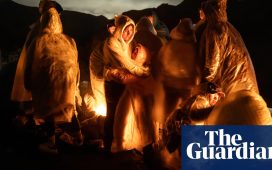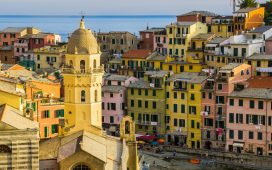
A grandmother has won a Nasa competition after capturing an image of a nebula 5,000 light years away from her back garden.
Jean Dean, 60, submitted the picture of the Rosette Nebula to the space agency’s daily photography contest and was shocked when it was selected as the winner.
The amateur astronomer’s photo was taken over five nights outside her home on the Channel Island of Guernsey, requiring 12 hours of exposure to show an interstellar cloud of dust stretching 590 trillion miles in diameter.
Ms Dean, a retired oceanographer, said she was notified by email a few hours before the picture went live on Nasa’s website that she had won its Astronomy Picture of the Day.
“As an amateur, to have an image picked is a great honour and it was a marvellous surprise,” she said. “My interest in astronomy came from when I was a child. We are very fortunate in Guernsey to have some really dark skies in certain areas.”
1/15
New images of Jupiter taken by NASA’s Juno spacecraft have been turned into stunning abstract artworks through a simple process of colour enhancement.
NASA/JPL-Caltech/SwRI/MSSS/Kevin M. Gill
2/15
The gas giant’s stormy atmosphere lends itself well to photography as clouds constantly swirl around each other to form beautiful patterns.
NASA/JPL-Caltech/SwRI/MSSS/Gerald Eichstädt/Seán Doran
3/15
Juno has been orbiting Jupiter since July 2016 and often sends images back to Earth, with the most recent being captured early in February.
NASA/JPL-Caltech/SwRI/MSSS/Kevin M. Gill
4/15
NASA releases the images and encourages members of the public to play with them.
NASA/JPL-Caltech/SwRI/MSSS/Gerald Eichstädt/Seán Doran
5/15
A storm with bright cloud tops in the Jupiter’s northern hemisphere.
NASA/JPL-Caltech/SwRI/MSSS/Matt Brealey/Gustavo B C
6/15
Jets and vortexes in Jupiter’s North Temperate Belt.
NASA/JPL-Caltech/SwRI/MSSS/Kevin M. Gill
7/15
Storms in Jupiter’s northern hemisphere.
NASA/JPL-Caltech/SwRI/MSSS/Rick Lundh
8/15
A swirling, oval white cloud in Jupiter’s South Temperate Belt. Known as White Oval A5, it is an anticyclonic storm
NASA/JPL-Caltech/SwRI/MSSS/Kevin M. Gill
9/15
A high altitude cloud formation in Jupiter’s North Temperate Belt Region.
NASA/JPL-Caltech/SwRI/MSSS/Jason Major
10/15
Swirls in Jupiter’s volatile northern hemisphere are captured in this color-enhanced image. Bursts of bright-white “pop-up” clouds appear scattered throughout the scene, with some visibly casting shadows on the neighboring cloud layers beneath them. Juno scientists are using shadows to determine the distances between cloud layers in Jupiter’s atmosphere, which provide clues to their composition and origin.
NASA/JPL-Caltech/SwRI/MSSS/Gerald Eichstäd/Seán Doran
11/15
A huge storm in Jupiter’s northern hemisphere. The storm is rotating counter-clockwise with a wide range of cloud altitudes. The darker clouds are expected to be deeper in the atmosphere than the brightest clouds.
NASA/JPL-Caltech/SwRI/MSSS/Gerald Eichstäd/Seán Doran
12/15
Juno captured this image when the spacecraft was 11,747 miles above the clouds.
NASA/JPL-Caltech/SwRI/MSSS/Gerald Eichstäd/Seán Doran
13/15
Juno captured this image when the spacecraft was 8,292 miles above the clouds in Jupiter’s northern hemisphere.
NASA/JPL-Caltech/SwRI/MSSS/Gerald Eichstäd/Seán Doran
14/15
The easternmost edge of Jupiter’s Great Red Spot and the surrounding south tropical disturbance.
NASA/JPL-Caltech/SwRI/MSSS/Kevin M. Gill
15/15
Jupiter’s Great Red Spot, a storm with over twice the diameter of earth that has been observed since at least the mid-19th century.
NASA/JPL-Caltech/SwRI/MSSS/ Gerald Eichstädt /Seán Doran
1/15
New images of Jupiter taken by NASA’s Juno spacecraft have been turned into stunning abstract artworks through a simple process of colour enhancement.
NASA/JPL-Caltech/SwRI/MSSS/Kevin M. Gill
2/15
The gas giant’s stormy atmosphere lends itself well to photography as clouds constantly swirl around each other to form beautiful patterns.
NASA/JPL-Caltech/SwRI/MSSS/Gerald Eichstädt/Seán Doran
3/15
Juno has been orbiting Jupiter since July 2016 and often sends images back to Earth, with the most recent being captured early in February.
NASA/JPL-Caltech/SwRI/MSSS/Kevin M. Gill
4/15
NASA releases the images and encourages members of the public to play with them.
NASA/JPL-Caltech/SwRI/MSSS/Gerald Eichstädt/Seán Doran
5/15
A storm with bright cloud tops in the Jupiter’s northern hemisphere.
NASA/JPL-Caltech/SwRI/MSSS/Matt Brealey/Gustavo B C
6/15
Jets and vortexes in Jupiter’s North Temperate Belt.
NASA/JPL-Caltech/SwRI/MSSS/Kevin M. Gill
7/15
Storms in Jupiter’s northern hemisphere.
NASA/JPL-Caltech/SwRI/MSSS/Rick Lundh
8/15
A swirling, oval white cloud in Jupiter’s South Temperate Belt. Known as White Oval A5, it is an anticyclonic storm
NASA/JPL-Caltech/SwRI/MSSS/Kevin M. Gill
9/15
A high altitude cloud formation in Jupiter’s North Temperate Belt Region.
NASA/JPL-Caltech/SwRI/MSSS/Jason Major
10/15
Swirls in Jupiter’s volatile northern hemisphere are captured in this color-enhanced image. Bursts of bright-white “pop-up” clouds appear scattered throughout the scene, with some visibly casting shadows on the neighboring cloud layers beneath them. Juno scientists are using shadows to determine the distances between cloud layers in Jupiter’s atmosphere, which provide clues to their composition and origin.
NASA/JPL-Caltech/SwRI/MSSS/Gerald Eichstäd/Seán Doran
11/15
A huge storm in Jupiter’s northern hemisphere. The storm is rotating counter-clockwise with a wide range of cloud altitudes. The darker clouds are expected to be deeper in the atmosphere than the brightest clouds.
NASA/JPL-Caltech/SwRI/MSSS/Gerald Eichstäd/Seán Doran
12/15
Juno captured this image when the spacecraft was 11,747 miles above the clouds.
NASA/JPL-Caltech/SwRI/MSSS/Gerald Eichstäd/Seán Doran
13/15
Juno captured this image when the spacecraft was 8,292 miles above the clouds in Jupiter’s northern hemisphere.
NASA/JPL-Caltech/SwRI/MSSS/Gerald Eichstäd/Seán Doran
14/15
The easternmost edge of Jupiter’s Great Red Spot and the surrounding south tropical disturbance.
NASA/JPL-Caltech/SwRI/MSSS/Kevin M. Gill
15/15
Jupiter’s Great Red Spot, a storm with over twice the diameter of earth that has been observed since at least the mid-19th century.
NASA/JPL-Caltech/SwRI/MSSS/ Gerald Eichstädt /Seán Doran
Ms Dean explained that the winning image “can be from any source such as a research observatory, the Hubble Space Telescope or an amateur astronomer”.
She added: “It serves as a database for deep space images and is a tremendous educational tool for schools, universities and the general public.
“People often think that the space between the stars is empty. In fact there are large, extremely dense clouds of material comprising gas such as hydrogen and interstellar dust.”
The 60-year-old added: “These regions are called giant molecular clouds and are very important as they are the birthplace of new stars which leads to the creation of the solar systems with planets and moons and the possibility of life.
“I encourage anyone to come up here and have a look, we’re trying to encourage people to look up at the skies more.”
The Rosette Nebula is located in the Monoceros region of the Milky Way, spanning a region equivalent to three full moons as viewed from Earth.
Ms Dean said she wanted to dedicate her photo of the nebula to friend and fellow astrophotographer Trevor Mahy, who recently died.
The Astronomy Picture of the Day is supported by NASA and has showcased the best astrophotography images since 1995.














